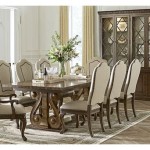How To Repair Wood Furniture
Repairing wood furniture can be a daunting task, but it's definitely possible with the right tools and techniques. Whether you're dealing with scratches, dents, or even broken pieces, there's a solution that can help you restore your furniture to its former glory.
Here's a step-by-step guide on how to repair wood furniture:
1. Assess the Damage
Before you start repairing, it's important to assess the damage and determine the best course of action. If the damage is minor, such as a scratch or dent, you may be able to repair it yourself with a few simple tools. However, if the damage is more severe, such as a broken leg or a large crack, you may need to seek professional help.
2. Gather the Necessary Tools
Once you've assessed the damage, you'll need to gather the necessary tools. For minor repairs, you'll likely need a few basic items, such as a hammer, nails, sandpaper, wood glue, and a putty knife. For more extensive repairs, you may need more specialized tools, such as a drill, saw, or clamps.
3. Clean the Damaged Area
Before you start repairing, it's important to clean the damaged area. This will help remove any dirt or debris that could interfere with the repair process. You can use a soft cloth and a mild detergent to clean the area. Once the area is clean, allow it to dry completely.
4. Repair the Damage
Now it's time to repair the damage. The specific repair method will depend on the type of damage you're dealing with. Here are a few common repair techniques:
- Scratches: For minor scratches, you can use a furniture scratch repair kit to fill in the scratch and blend it with the surrounding wood.
- Dents: For dents, you can use a steam iron to gently raise the dented area. You can also use a damp cloth and a hammer to gently pound out the dent.
- Cracks: For cracks, you can use wood glue to fill in the crack and clamp it together until the glue dries.
- Broken Legs: For broken legs, you may need to use a drill and screws to reattach the leg. You can also use wood glue to strengthen the joint.
5. Sand and Finish the Repaired Area
Once the repair is complete, you'll need to sand and finish the repaired area. This will help blend the repaired area with the surrounding wood and give it a professional-looking finish. You can use a fine-grit sandpaper to smooth out the repaired area. Once the area is sanded, you can apply a clear finish, such as polyurethane or lacquer, to protect the repaired area.
Tips for Repairing Wood Furniture
Here are a few tips to help you repair wood furniture more effectively:
- Use the right tools for the job. The wrong tools can make the repair process more difficult and may even damage the furniture further.
- Take your time. Rushing the repair process can lead to mistakes. Be patient and take your time to do the job right.
- Test the repair before you finish it. This will help you ensure that the repair is holding up and that the furniture is structurally sound.
- If you're not comfortable repairing the furniture yourself, don't hesitate to seek professional help. A professional furniture repairer can quickly and efficiently repair your furniture to its former glory.

How To Repair Wood Furniture Girl In The Garage
How To Fix Chipped Wood Furniture Ifixit Repair Guide

Wood Furniture Repair Solution Diy Rescue Do Dodson Designs

Split Wood Repair From Movement Furniture Restoration How To
How To Repair Wooden Furniture Surfaces Tips Howstuffworks

The Best Way To Fix Chipped Wood Furniture
How To Fix Chipped Wood Furniture Ifixit Repair Guide

How To Glue Wood Furniture Parts Repair Youtube

Wood Furniture Repair Solution Diy Rescue Do Dodson Designs

Repairing Wood Furniture With Bondo To Fix A Missing Chunk Of My Dog Ate Bed
See Also








